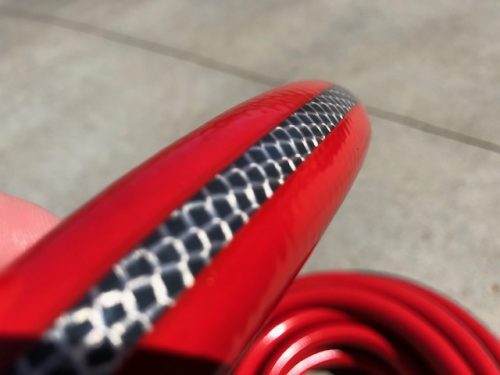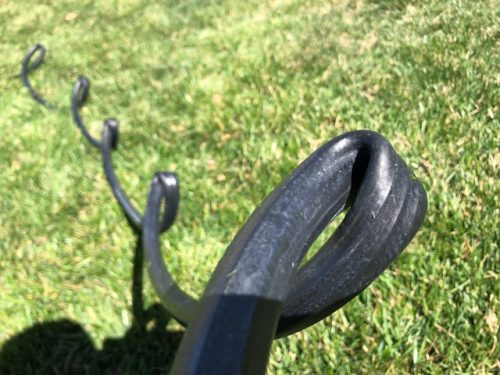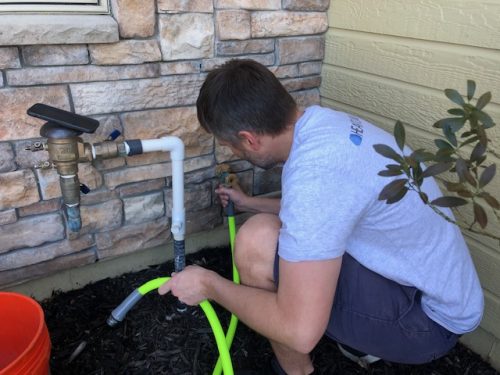Garden hoses are relatively easy to use but there are a few common issues that can arise. Most of these issues have easy and cheap fixes. Here are some of the most common issues surrounding garden hoses.
- The hose wears out faster than expected
- The hose leaks around the spigot
- The hose cracks and forms leaks
- The hose kinks and does not work properly
- The hose is not stored properly
- The user doesn’t understand what flow rate they need
Learning the basics on how to use a garden hose will help you avoid these issues. Lets take a look at these issues individually and discuss their solutions.
Table of Contents
6 Common Issues People Face when Using Garden Hoses
The Hose Wears out Faster than Expected
Standard garden hoses are typically made of vinyl, rubber and occasionally other materials (best hose materials). Vinyl and rubber have significant differences. Here is what you need to know:
- Vinyl hoses: Vinyl hoses are usually cheaper than rubber hoses. But there are also more expensive versions of vinyl hoses that use reinforcement inside the hose to prevent kinking. For example, in the kink-resistant vinyl hose pictured below you can see reinforcement braiding inside the hose.

- Rubber hoses: Rubber hoses are more expensive but are very durable and also very easy to maneuver (flexible). But because they are so flexible, rubber hoses also are prone to kinking. Rubber:

Besides material, there are several other reasons why hoses will wear out quicker than expected. Those include improper storage, prolonged exposure to sun and weather, crushing, kinking, and using improper water pressure.
In some cases small leaks can be repaired, but many times the hose needs to be replaced. To prevent the hose from wearing out, make sure it is stored properly.
Garden hose reels and garden hose hangers are a good way to keep the hose out of the elements, and they help prevent kinking and cracking. To view options, visit our article about the best metal garden hose reels. Always make sure the pressure rate of your hose is compatible with the pressure of the water source.
The Hose Leaks Around the Spigot
The most common place for the hose to leak is around the spigot. This is often due to a loose or improper connection between the hose and spigot.

First, check to make sure the hose is screwed on correctly. It is very easy to cross-thread the hose when screwing it on.
To check this, unscrew the hose and make sure the threads are aligned before tightening again. Once the hose is threaded correctly, make sure it is screwed on tightly to the spigot.
If this doesn’t solve the issue, you may have a problem with your gasket or fitting.
- Check to see if the gasket is missing or cracked. If you need to replace it, use a flathead screwdriver to pop out the gasket and help secure the new one in place. If the gasket isn’t missing or cracked, it is likely not the problem.
- If the gasket isn’t the problem, you may have to replace the actual hose fitting itself. These fittings can deteriorate from normal wear and tear. You can pick up a replacement kit from your local hardware store.
Although gaskets and fittings can wear out over time, again, the most common cause for a leak around the spigot is a loose or improper connection between the hose and spigot. So make sure to check the connection first.
The Hose Cracks and Forms Leaks
Even though a leak near the spigot is very common, it isn’t the only place leaks appear. Cracks and leaks can form throughout the whole hose. There are several reasons why a hose becomes damaged and leaks. Here are 3 common reasons:
- Punctures: When you maneuver your hose across the yard rocks and other debris can damage it. Also, running over it with your lawn mower or car can cause cracks and leaks to form.
- Weather: The sun’s UV rays can deteriorate a hose which can lead to cracks and leaks. Exposure to extreme temperatures and other inclement weather such as wind and hail can also damage a hose.
- Kinks: When your hose kinks it creates pressure points that can cause cracks. Buying a hose with kink-resistant material can help remove this issue and make the host last longer.
Once you’ve assessed the kind of damage your hose has sustained, you can determine whether or not it needs fixed or replaced. Repair kits for garden hoses are available at your local hardware store. Just be aware that some holes are too large to repair with these kits.
Most of these repair kits are simple to use, just make sure to follow the packaging instructions. For more minor leaks, temporary fixes like duct tape can save you until the hardware store opens.
The Hose Kinks and Does Not Work Properly
Kinking is the term used when your hose forms tight pressure points that make it difficult for the water to get through. Most kinks are minor enough to unkink with your hands, but some kinks are more serious and can damage the hose over time.
Here are 3 simple ways to keep your hose from kinking:
- Extend the hose prior to use. Take the time to straighten out the hose before turning on the water. Don’t keep the hose coiled up when you turn on the water.
- Buy a hose with kink preventer. A kink preventer is a small attachment that encases the ends of the hose to prevent kinking near the spigot. You can buy these off Amazon, or buy a hose that comes with these already built in. Yes, this helps kinking near the spigot, but doesn’t mean you won’t get kinks in the middle of your hose. Here’s what a kink preventer looks like:

- Use a storage reel. These are effective at storing the hose safely, and can help prevent kinking. No, these won’t prevent all kinking, and some types of reels work better than others, but using a storage reel is a much better option than simply throwing the hose in the corner of the garage. There are many hose reels on the market but hand crank hose reels will likely give you the greatest selction.
Visit our water hose kink guide if you want to read more information on kinking, including other tips to prevent them.
The Hose is Not Stored Properly
How you store your hose can affect its longevity and durability over time. Remember to empty as much water out of the hose as possible before storing it to reduce the possibility of rot. This also prevents damage from the expansion of ice if there’s a possibility of freezing.
When putting your hose away, if you are coiling it manually, make sure to coil your hose loosely, in roughly two-to-three-foot-diameter loops depending on the length and thickness, so that it doesn’t kink or crack.
There are a few different ways to store garden hoses long-term:
- One of the most popular is a hose reel cart which makes it easy to spiral the hose around a central drum, which evenly distributes the weight and keeps the coils symmetrical.
- You can also choose to hang your hose from a hook, which needs to be wide enough to distribute the weight evenly. Make sure the hose doesn’t have any dry kinks in it when stored.
The User Doesn’t Understand What Flow Rate They Need
Flow rate is the amount of water that comes out of the hose during a time period, which is typically measured in gallons per minute. Knowing your flow rate will allow you to know how long to use your hose.
Please understand that the water pressure for your home will also affect the flow rate. Most homes will have water pressure in the 40-60 PSI range. As you can see, mine is around 60 PSI when I test it:

But water pressure isn’t the only thing that can affect flow rate. Buying a hose with a smaller diameter will result in a lower flow rate.
The standard hose diameter is 5/8″. The most common smaller diameter is 1/2″. A smaller diameter hose will be a good idea for those that want the hose to be lightweight. Just remember, this means you will spend more time completing your task.
Yes, higher flow rate will mean you can get your job done faster, but the larger-diameter hose will be heavier. Keep in mind that high pressure can also damage more delicate items like plants in your garden. The length of your hose will also affect flow rate – for most yards, a 50 foot hose is the best choice.
